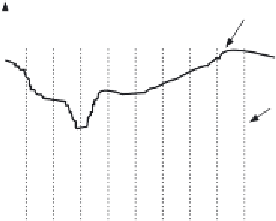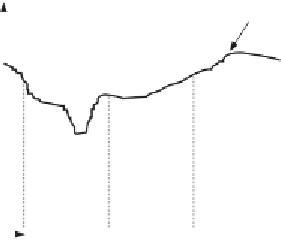Image Processing Reference
In-Depth Information
Amplitude
Amplitude
Signal
Signal
Sampling
instants
Sampling
instants
Time
Time
∆
t
(a) Sampling at high frequency
∆
t
(b) Sampling at low frequency
Figure 2.7
Sampling at different frequencies
signal's
spectrum
exists only between these frequencies. This function is sampled every
∆
t
s: this is a sampling function of spikes occurring every ∆
t
s. The Fourier transform of the
sampling function is a series of spikes separated by
f
sample
= 1/∆
t
Hz. The Fourier pair of
this transform was illustrated earlier, Figures
2.6
(g) and (h).
The sampled signal is the result of multiplying the time-variant signal by the sequence
of spikes, this gives samples that occur every ∆
t
s, and the sampled signal is shown in
Figure
2.9
(a). These are the outputs of the A/D converter at sampling instants. The frequency
domain analogue of this sampling process is to
convolve
the spectrum of the time-variant
signal with the spectrum of the sampling function. Convolving the signals, the convolution
process, implies that we take the spectrum of one,
flip
it along the horizontal axis and then
slide
it across the other. Taking the spectrum of the time-variant signal and sliding it over
the spectrum of the spikes, results in a spectrum where the spectrum of the original signal
is
repeated
every 1/∆
t
Hz,
f
sample
in Figures
2.9
(b-d). If the spacing between samples is ∆
t
,
the repetitions of the time-variant signal's spectrum are spaced at intervals of 1/∆
t
, as in
Figure
2.9
(b). If the sample spacing is
small
, then the time-variant signal's spectrum is
replicated close together and the spectra
collide
, or interfere, as in Figure
2.9
(d). The
spectra just
touch
when the sampling frequency is
twice
the maximum frequency in the
signal. If the frequency domain spacing,
f
sample
, is
more
than twice the maximum frequency,
f
max
, the spectra do
not
collide or interfere, as in Figure
2.9
(c). If the sampling frequency
exceeds twice the maximum frequency then the spectra cannot collide. This is the Nyquist
sampling criterion:
In order to reconstruct a signal from its samples, the sampling frequency must
be at least twice the highest frequency of the sampled signal.
If we do not obey Nyquist's sampling theorem the spectra collide. When we inspect the
sampled signal, whose spectrum is within -
f
max
to
f
max
, wherein the spectra collided, the
corrupt spectrum implies that by virtue of sampling we have
ruined
some of the information.
If we were to attempt to reconstruct a signal by inverse Fourier transformation of the
sampled signal's spectrum, processing Figure
2.9
(d) would lead to the wrong signal whereas
inverse Fourier transformation of the frequencies between -
f
max
and
f
max
in Figures
2.9
(b)






























